12 benefits with dumbbells
12 benefits of working out with dumbbells
– and why they outperform other equipment
In this article, we're going to explore all the benefits of using dumbbells in your workouts, both:
- in comparison to other training equipment
- with a deep dive into their health benefits, from building muscle and burning fat to improving bone density and balance.
And after our dumbbell deep dive, you’ll get not only one, but two bonus pieces of content:
Bonus #1! Boost your training with smart technology
Bonus #2! 5 tips to maximize your training to get stronger in less time
Can I build muscle with dumbbells?
12 benefits compared to other training equipment
Strength training – and overall health benefits
How heavy do I need my dumbbell to be?
Bonus #1
How to boost your training with smart technology
Bonus #2
5 ways of getting stronger – in less time
Dumbbells are for everyone
Dumbbells. Those are just those little weights you see people using at the gym, right? Those things overzealous exercisers fling to the floor when they're feeling really good? Wrong. And also, right! Dumbbells might be mini, but they’re mighty. Think of them as the Swiss Army Knife of the fitness world – versatile, efficient, and super effective.
For example, using dumbbells is a great way to check off the US Department of Health’s recommended regimen of twice-weekly resistance training. They can be used at any fitness level and for a great number of different exercises. For focused training and whole-body workouts alike.
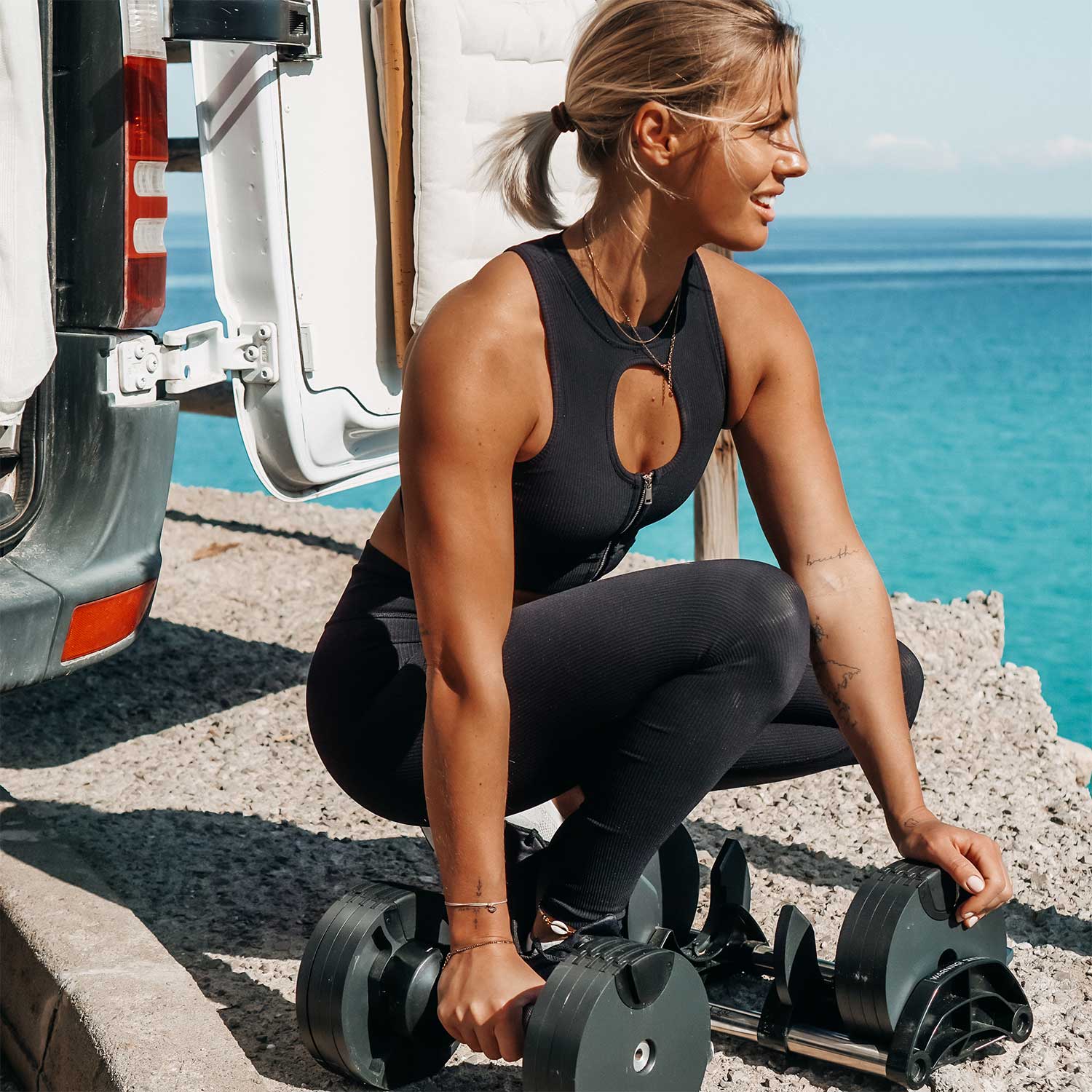
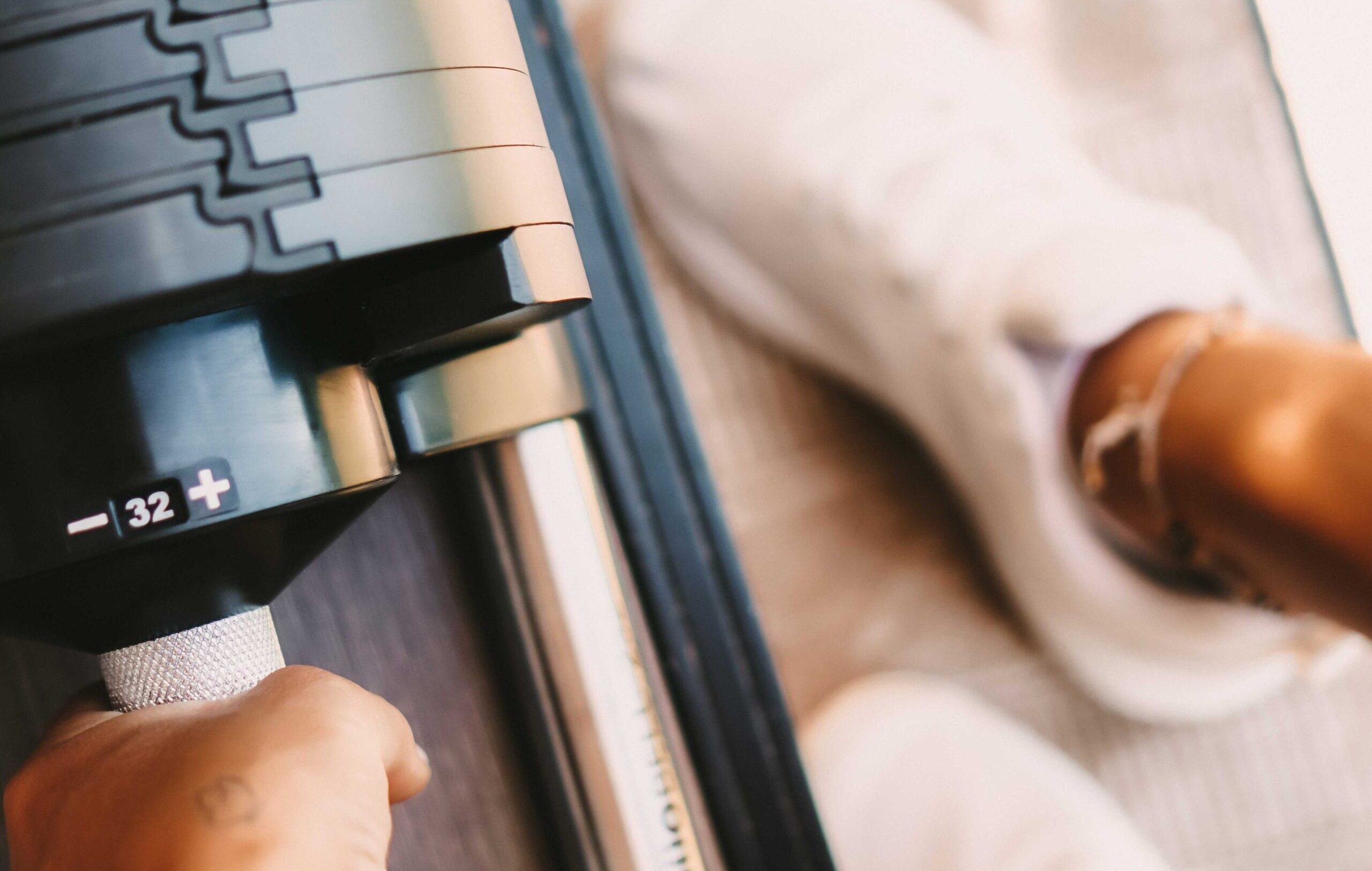
Can I build muscle with dumbbells?
One of the most common questions when it comes to dumbbells is: Can I build enough muscles and get strong using dumbbells? The straightforward answer is: yes.
Research* shows that training with free weights or machines can give you similar increases in muscle mass and strength. The important thing is to find what kind of training you enjoy the most and stick with it. So if you ever questioned whether you can build muscles with dumbbells, doubt no longer! These little miracles really do work.
However, building muscles should not be your only consideration when choosing workout equipment. As we’ll detail below, exercising with dumbbells has numerous benefits compared to other equipment.
* Journal of Sports Medicine and Physical Fitness (Aug 2022) & The Journal of Strength and Conditioning Research (Jul 2020)
12 benefits compared to other training equipment
1. Simplicity & easy access
2. Challenge stability
3. Eliminates imbalances
4. More natural movements
5. Greater variety
6. Cost-effective
7. Portability
8. Work in different planes of motion
9. Enhances functional fitness
10. Versatility
11. Convenience
12. Can be used by beginners and experience
1. Simplicity & easy access
One of the most beautiful (yes, we said beautiful) things about dumbbells is how they embody the essence of simplicity. They are easy to use, require minimal setup, and adapt to a wide range of exercises and fitness levels. Whether you're a seasoned athlete or a complete beginner, dumbbells can offer a path to strength and fitness that is both accessible and rewarding. Dumbbells may seem humble, but they offer a gateway to a world of physical and mental transformation.
So if you're seeking a way to simplify your fitness routine without sacrificing results, try dumbbells. You may be surprised at the power these unassuming weights can bring to your life.
2. Challenge stability
Unlike machines or other gym equipment that isolate specific muscles, dumbbells require you to use your body as the stabilizer to perform exercises effectively. These stabilizer muscles, located throughout our body, like your core, are responsible for keeping you balanced and upright.
By engaging these stabilizing muscles when you work out, you will increase the stability in your body.
A study in Bioengineering (Basel) (June 2022) on whether different kinds of equipment had any impact when doing lunge squats concluded that dumbbells were the best choice for beginner weight lifters, thanks to the fact that dumbbells challenge stability. High five, little friends!
Another way that dumbbells can improve your stability is when performing compound exercises. These exercises work multiple muscle groups and joints simultaneously, so you get a lot of bang for your buck. And doing them with dumbbells makes it even more challenging, leading to greater stability and balance.
Take the dumbbell thruster, for example. This exercise combines a front squat with an overhead press, so you perform two movements at once. Pulling off this exercise takes a great deal of coordination and stability, but the benefits are worth it.
And who knows, maybe you'll even be able to balance on one foot while juggling dumbbells someday! (Okay, perhaps not that last part, but you get the idea.)
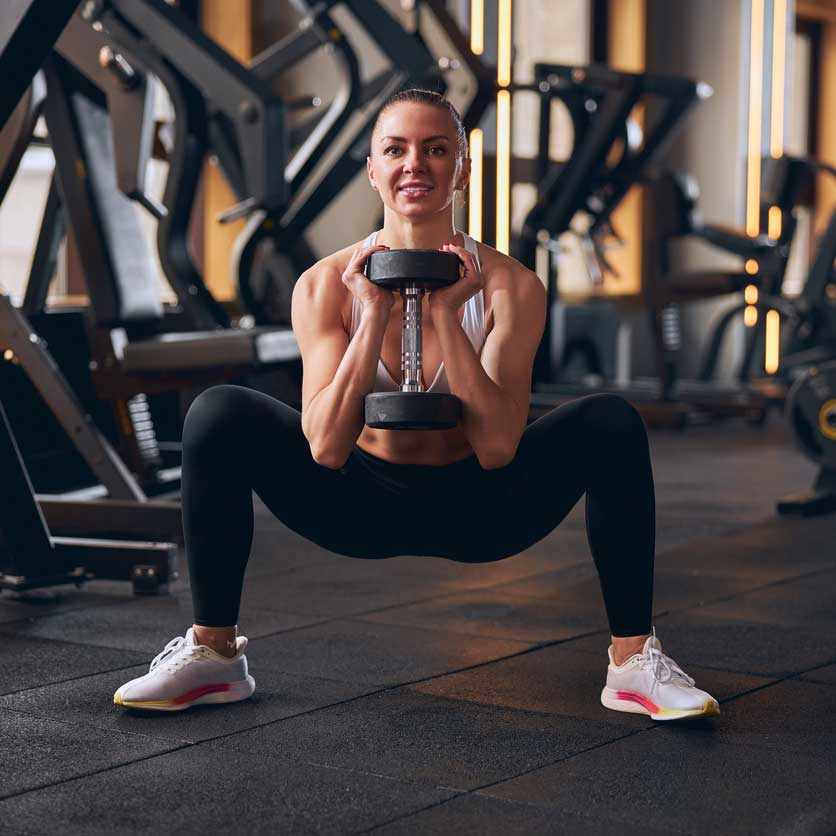
Are you new to squatting and wonder how deep you should go? 90 degrees in the knees? Deeper than that? Livestrong has written a great article about how deep you really need to go when squatting.
3. Eliminates imbalances
It's not unusual that one side is stronger than the other. For example, if you've been favoring one side of your body due to an injury or weakness, using dumbbells can help to even out the workload and build strength where needed. Also, with some training equipment, like a weightlifting machine or a barbell, the weaker side can get (unwanted) support from the stronger.
When using dumbbells, the left and right sides will work independently from one another, which can help identify and correct any imbalances that may be present, leading to greater symmetry.
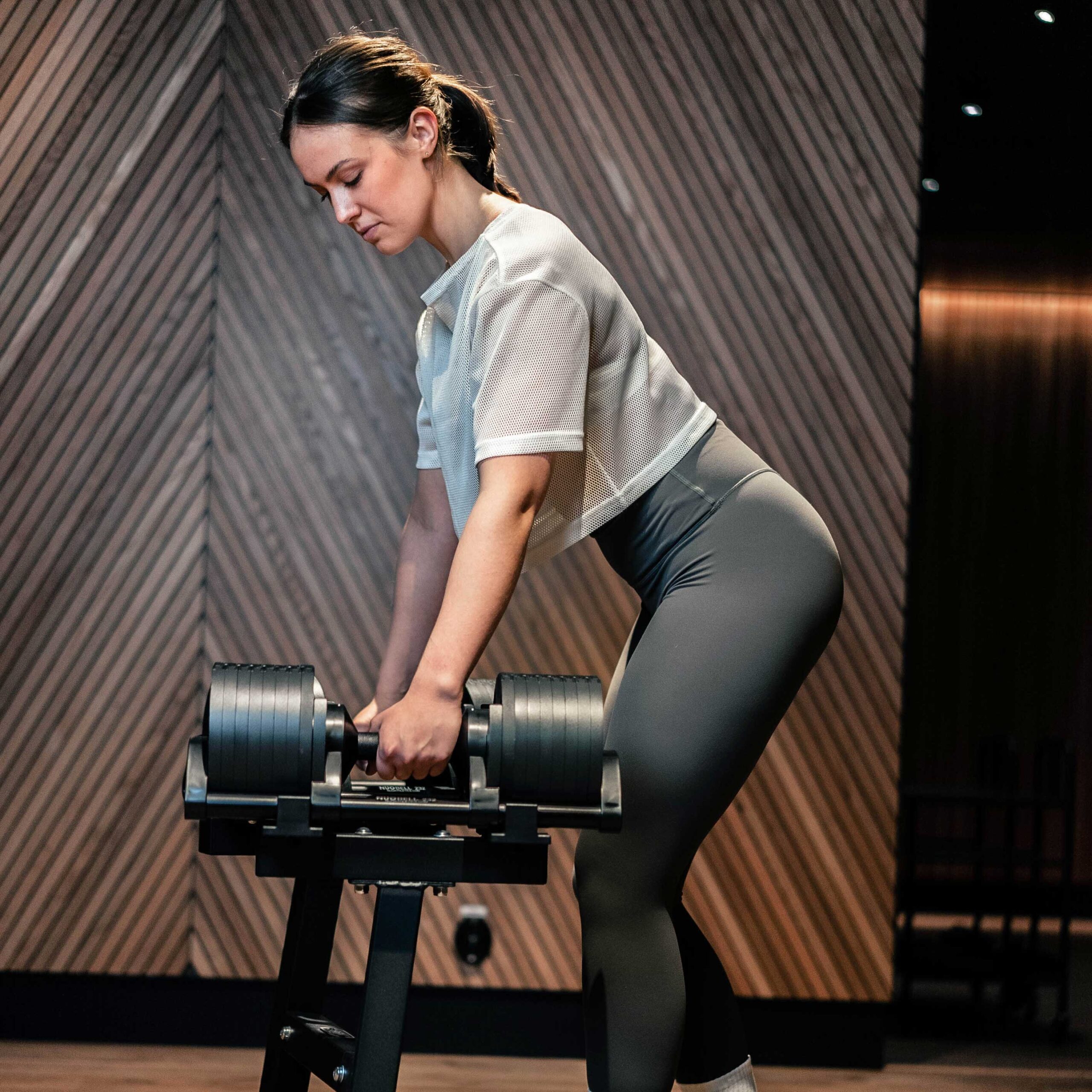
4. More natural movements
When it comes to strength training, dumbbells offer a way to harness that natural movement and incorporate it into our workouts.
Unlike some weight machines that can force our bodies into unnatural or locked positions, dumbbells allow us to move freely and more naturally. For instance, when doing dumbbell curls, we can use a neutral grip, moving the arms independently from each other, which more closely mimics the natural movement of our arms.
This natural movement not only feels good, but it also helps to activate more muscles and improve overall functional fitness. So, embrace the simplicity of the dumbbell and allow yourself to move with ease and grace.
5. Greater variety
Unlike some gym machines that limit our movements to a fixed range, dumbbells offer endless possibilities for exercise variety. You can use them for traditional strength training exercises like bicep curls and chest presses, or you can get creative and use them for more dynamic movements like wood chops and renegade rows.
Plus, with adjustable dumbbells, you can easily change the weight to add more resistance or perform drop sets for a bigger challenge. And let's remember the versatility of using a single dumbbell for unilateral exercises, which can help to correct muscle imbalances and improve overall stability. The possibilities are truly endless!
6. Cost-effective
Dumbbells offer a more cost-effective option for strength training compared to other equipment.
You see, other strength training equipment can be quite costly and may even require a membership to a fancy gym. But dumbbells can be purchased for a reasonable price and used at home or even in a public park—no need to break the bank or restrict yourself to a specific location. With dumbbells, you can exceed your fitness goals without breaking the bank.
And as we mentioned before, the versatility of dumbbells means you can perform various exercises with just one or two weights, making them a wise investment for any fitness level or goal - doubly so with adjustable dumbbells, which offer many different weight options.
7. Portability
Going away for the weekend, but want to bring the possibility to work out? A pair of dumbbells can easily tag along since they do not take up much space.
And with adjustable dumbbells, your options explode, allowing you to perform whole-body workouts with different weights wherever you wake up. So say hello to a world of anywhere exercise!
Here are just a few ways that adjustable dumbbells offer on-the-go benefits:
Compact size: Unlike traditional dumbbells that come in a variety of weights and take up space, adjustable dumbbells are designed to be compact and take up less room, making them easy to store at home or in your car when traveling.
Easy to transport: Adjustable dumbbells often come with a carrying case or rack, making them easy to transport from place to place. You can take them to the park, on a road trip, or even to the office for a quick workout during lunch break.

8. Work in different planes of motion
The planes of motion are the different ways you can move your body. There are three main planes:
- The sagittal plane is when you move forward and backwards, like walking or doing a bicep curl.
- The frontal plane is when you move side to side, like when you do a side lunge or jumping jacks.
- The transverse plane is when you rotate or twist, such as swinging a golf club or doing Russian twists.
The benefit of working in different planes of motion with dumbbells is that it helps you build strength and stability in all directions, which can help prevent injuries and improve your overall fitness.
By using a barbell for biceps curls, for example, you can only lift the barbell up and down. But with dumbbells, you can rotate your lower arms away from your body, creating another angle and activating other muscles. This way, you can ensure that you're building a well-rounded, balanced physique.
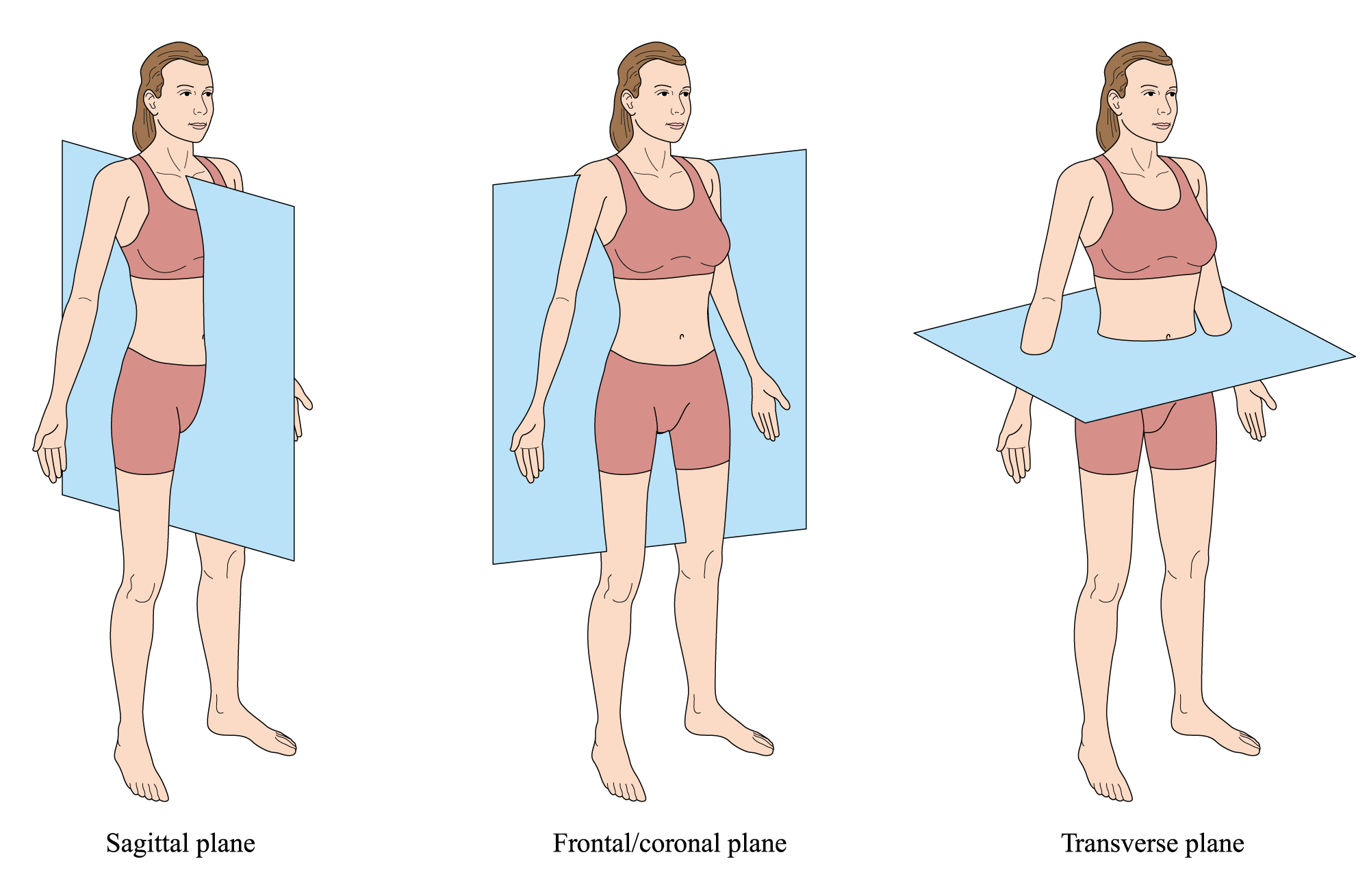
9. Enhances functional fitness
Functional fitness is all about being able to perform daily tasks with ease and efficiency. Using dumbbells in your workouts can help you develop the strength and coordination you need to move and perform everyday activities better.
For example, lifting a heavy bag of groceries or picking up a child requires strength in your upper body and stability and coordination throughout your entire body. By using dumbbells in exercises like chest presses, rows, and lunges, you can build strength in your arms, shoulders, back, and legs while improving your balance and coordination.
Incorporating dumbbell exercises into your fitness routine can help you develop the functional fitness you need to move more easily and confidently through your daily life.
10. Versatility
Think of dumbbells as a multipurpose tool for your workout.
With just a pair of adjustable dumbbells, or a set of fixed dumbbells, you can do all sorts of exercises that will hit different muscle groups and give you a full-body workout. We're talking squats, lunges, curls, presses, rows, and more! The best part? Dumbbells let you move in different directions and angles to target those muscles in ways a static gym machine can only dream of (if, indeed, they could dream).
And remember that you can change the weight when using adjustable dumbbells, so you can vary the intensity of your workout, challenge yourself to keep your body guessing, and let constant progression be a natural part of your everyday fitness.
11. Convenience
Dumbbells are the ultimate convenience tool for getting fit and strong. No gym membership is required, and no complicated machines - it's just you and those little iron gadgets.
You can use dumbbells just about anywhere, anytime. They're perfect for your home gym or hotel room when you're on the road. And you don't need a PhD to figure out how to use them, either.
And last but not least, as mentioned before but deserves repeating, you can work out pretty much any muscle group you want, with tons of exercises to choose from.
12. Can be used by beginners and experienced
One of the top benefits of dumbbells is that they can be used regardless of experience. They are just as great for beginners as they are for seasoned pros.
Beginners
Let's compare dumbbells to barbells or weight machines. Sure, the latter have their place, but they can be intimidating for newbies. Plus, you need to know how to use them properly, which can take some time to learn. Dumbbells, however, are so simple that even your grandma can use them. Go Gammy!
And let's talk safety. With dumbbells, you don't have to worry about dropping a heavy barbell on your head or getting trapped under a weight machine. If you can't complete an overhead set with dumbbells, you can just set them down and take a breather.
Another great thing about dumbbells is that you can start with small weights and increase in tiny increments. That means you can build strength gradually without feeling like you're going to rip your arms off.
Experienced
Dumbbells are a great way to add variety to your workout routine. With a greater range of motion than machines, you can target specific muscles more effectively and build strength and power. In addition, dumbbells are incredibly versatile and allow you to perform various exercises such as bench presses, rows, and even more advanced moves like Turkish get-ups and renegade rows (now we're rocking!). Incorporating dumbbells into your workout routine can enhance your muscle-building potential and challenge you in new ways.
Dumbbells are also a smart way to revitalize your workout routine with endless variation. Dumbbells also open the door for more advanced drop- and super-sets, techniques that are ideal for more experienced athletes who might feel a bit stuck in their progressions.
Strength training – and overall health benefits
Strength training will (duh) make you stronger and more muscular. With every weight you lift or resistance, you're creating tiny tears in your muscle fibers. Your body repairs them, and voilà, you end up with thicker, more defined muscles that will make you feel like a total boss.
But building muscles offers numerous health benefits besides the fact that you will get stronger. Strength training fits into a larger context of physical and mental health. By incorporating dumbbells into your training, you can improve your overall fitness and health and experience many of the positive effects that are the result of regular exercise.
Strength training is your new best friend, and here's why:
More endurance and energy
Strength training will give you the endurance and energy to take on the world. When your muscles and cardiovascular system are stronger, everyday tasks become easier and less tiring. Plus, strength training can help improve your mood and banish feelings of sluggishness or fatigue. So, don't hit the sack when you've had a tiring day. Instead, challenge your body with a workout. It will surely do the trick!
Improves sleep
Strength training improves sleep quality and duration for adults, regardless of age. So if you want to improve your sleep habits, incorporating regular strength training into your fitness routine may be helpful. A study published in the Journal of Sleep Research Studies showed that you can attain these positive effects if you add strength training three times per week. Indeed, the improvements in sleep may be due to the physiological effects of strength training, such as improved hormonal balance and metabolic function.

Improves bone health
It will give your bones the strength they need. Just like muscles, bones also get stronger when they're stressed. An article in Harvard Health states that strength training stresses your bones, stimulating them to grow denser and stronger. This is especially important for women, who are more likely to develop osteoporosis as they age.
Increases heart health
Did you think cardio was the only way to improve heart health? Think again. Strength training can reduce the risk of cardiovascular health for both younger, middle-aged and older people, an effect proven by studies published in the American Journal of Cardiology, European Journal of Applied Physiology and the Journal of Strength and Conditioning Research.
But you are not wrong about cardio. Cardio does improve your heart health. However, cardio combined with strength training will maximize your cardiovascular benefits more compared to cardio OR strength training alone. (PLOS One, 2019) Cardio and strength training is the PB & J of the fitness world - so much better together!
Improves balance and coordination
Strength training can be a game-changer for your balance and coordination. According to a study published in Journals of Strength and Conditioning Research, when you strengthen the muscles around your ankles, knees, and hips, you're building some serious strength and improving your joint stability. And let's face it, no one wants to fall like a tree when they're just trying to walk from the couch to the fridge, right?
By building up those muscles, you'll be able to support your joints, which means you'll be less likely to take a tumble and more likely to strut your stuff with confidence. No wobbling or tottering for you!
Supports weight loss
It will rev up your metabolism and burn fat like nobody's business. Muscle tissue burns more calories at rest than fat tissue, meaning that building more muscle will increase your basal metabolic rate (BMR), which is the number of calories your body burns at rest. And that translates into more calories burned throughout the day, which is helpful for weight loss and management.
One great way to lose body fat is to intensify your training, which requires a larger amount of energy, and as a result, consumes more calories. Dumbbells are like the secret weapon of this strategy: use them in high-intensity interval training (HIIT) and Tabata workouts. They can take a regular old cardio exercise and crank up the intensity to 11, giving you insane results in less time.
Intensify your workout with dumbbells
The goal of many HIIT workouts is to get your heart rate up super high in a short amount of time. And that's where dumbbells come in handy – using them during a workout will increase the intensity of the session, and that can help you burn fat while preserving muscle.
What dumbbell weight should you use for HIIT sessions? A 5kg or 10kg dumbbell should do the trick if you're doing an active cardio HIIT workout. But if you want to focus on those compound lifts and exert more energy in a shorter time, you can go up to a 10kg to 30kg dumbbell range. Just be prepared to feel the burn and expend some serious calories.
Improves glucose control
Building muscle through strength training has also been shown to improve glucose control and insulin sensitivity, reducing the risk of type 2 diabetes and other metabolic disorders. In one study in Harvard Health, participants who engaged in strength training had a 23% lower risk of developing type 2 diabetes than those who did not engage in strength training. Strength training has also been shown to improve blood pressure and cholesterol levels.
All of the above benefits are not only valid for strength training with dumbbells; they're also valid for all kinds of strength training. But as you have learned, dumbbells come with a heap of benefits compared to other ways of performing strength training. Nevertheless, the most important thing is that the strength training gets done, so use the equipment that suits you the best.
Did you know?
1. Strength training with dumbbells also supports cognitive function
Recent research from The University of Sydney has shown that using dumbbells for resistance training can support cognitive function by improving memory and attention. That means when you lift those weights, you're building muscle and giving your brain a workout! Who knew lifting weights could be good for your noggin?
2. Strength training with dumbbells also increases longevity
Yep. You will live longer. According to an article in New York Times, it's important to maintain our muscle mass and bone density for overall health and longevity as we get older. Resistance training with dumbbells can help prevent age-related declines in muscle mass and bone density so that you can stay strong and healthy well into your golden years. So grab those dumbbells and get lifting - your muscles and bones (and brain!) will thank you for it.
In short, working out with dumbbells is a great way to get strong and fit and has surprising benefits for your brain and overall health. So go ahead and add some dumbbell exercises to your fitness routine – you'll be surprised at how much of a difference it can make!
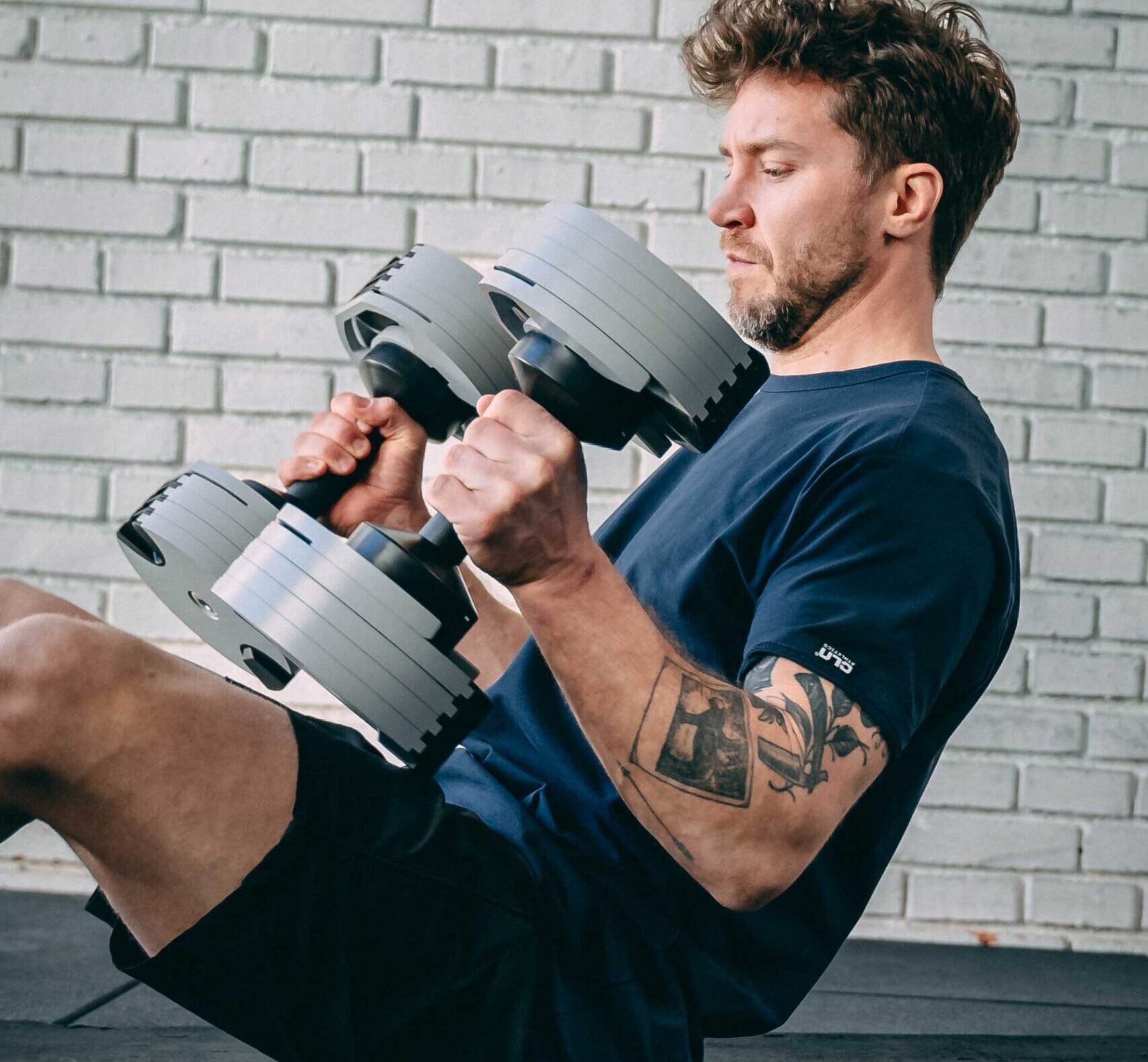
3. 1–1,5 hour per week is enough…
To attain the positive effects of strength training. Engage in strength training exercises two to three times per week, with each session lasting around 20-30 minutes. That's a total of 1–1,5 hours a week. No excuses, no procrastination – get in there and lift some weights!
4. …and consistency is key
And here's the kicker - you've got to keep it up consistently. None of this hit-and-miss business - if you want to see significant changes in muscle mass, strength, or any other physical markers, you must establish a regular strength training routine and stick to it like glue.
How heavy do I need my dumbbell to be?
Before you go Hulk-smashing those weights, remember to start with lighter weights or resistance and gradually increase the intensity as your strength and fitness levels improve. No need to injure yourself and end up in the ER, right?
Choose dumbbell weights – beginners
You might feel like starting harder than a rock, but that's just asking for an injury or a visit from the paramedics.
Instead, start with lighter weights and gradually work your way up. It's like training for a marathon - you wouldn't start by running a full marathon on your first day. The same goes for weightlifting.
A good rule of thumb is to start with weights you can lift for about 10–12 reps with good form and technique. If you can easily lift more than that, you might want to go up a weight, and if you can barely lift that much, you might want to go down a weight.
Now, don't get discouraged if you start with lighter weights than you thought you could handle. It's better to start light and build up gradually than to start heavy and end up with an injury.
And, hey, feel free to ask for help or advice from a qualified fitness professional, like a certified personal trainer. It's always better to ask one question too many thank risk getting injured. A pro can help you choose the correct weights and show you the proper form and technique to get strong safely.
So, there you have it – the secret to choosing the proper weights for your weightlifting journey. Remember, slow and steady wins the race!
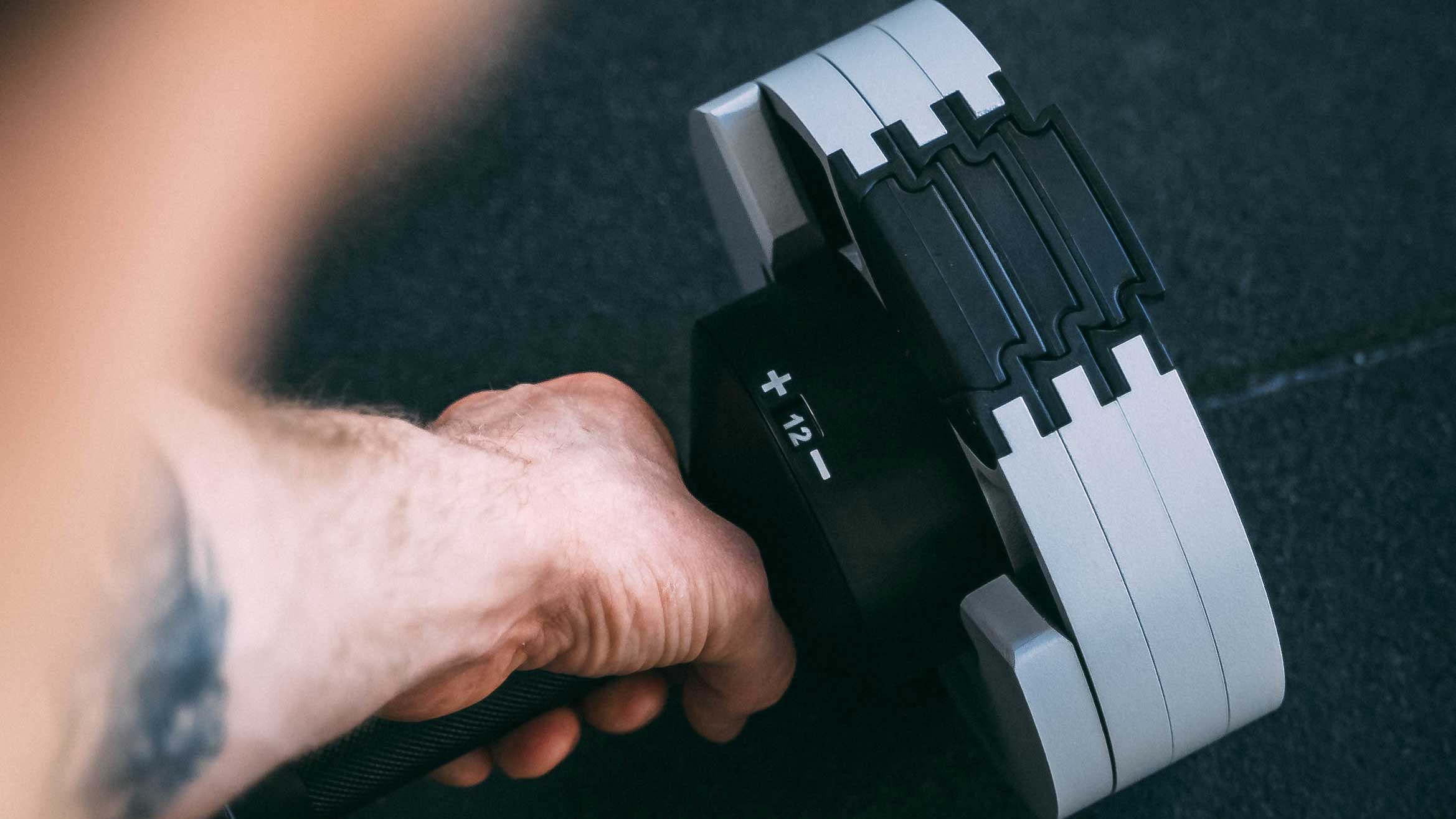
Choose weight – experienced
If you're a gym fanatic, you know the deal about weights. But let's refresh your memory:
First, let's be real here – you're not a beginner, so we won't start with baby weights. You need to challenge yourself with weights that are heavy enough to push you to your limits but not so heavy that you'll end up injured and unable to compete.
So, start by choosing weights you can lift for about 6–8 reps with good form and technique. We're talking heavy metal here!
But here's the thing – you can't stick with those heavy weights forever. You've got to keep pushing yourself to lift even heavier weights over time as your strength and fitness levels improve. The key is constantly pushing your strength boundaries forward, challenging those muscles more and more each day. That's how you become a true weightlifting beast!
And remember proper form and technique. You don't want to be that pro athlete known for lifting heavy weights with poor form whose never seen without a limp!
So, if you're not sure about your form or technique, don't be afraid to ask for help or advice from a qualified fitness professional, like a certified personal trainer. They'll ensure you're lifting those heavy weights like a pro and help you avoid any potential injuries.
Pain during or after training
Pain during or after working out can be a buzzkill. But don't worry. It's totally normal, especially if you're starting out with strength training.
Muscles train in a way they're not used to
One common cause of pain is DOMS, or delayed onset muscle soreness. It's basically your muscles throwing a temper tantrum because you're making them work in ways they're not used to. But that's just your muscles getting stronger and adapting to the new demands you're putting on them – it's a good thing.
Improper technique
Another cause of pain can be improper technique. That's not a good thing; it can lead to more severe injuries over time. So, ensure you're using the proper technique when lifting weights or doing exercises. Don't be that person who tries to lift the heaviest weight in the gym with bad form – that's just asking for trouble. Always make sure to choose weights after setting the proper techniques. Always.
Recovery
Now, if you're feeling pain during or after your workout, take a break and let your body rest and recover. You can also try icing or heating the affected area and taking some over-the-counter pain relievers if necessary.
If the pain persists or worsens, don't hesitate to seek advice from a qualified healthcare professional. They can evaluate your symptoms and help you determine the best course of action.
Remember, pain during or after working out doesn't have to be a deal-breaker. Take care of yourself, listen to your body, and don't be afraid to ask for help when needed.
Bonus #1
How to boost your training with smart technology
At the beginning of this article about the benefits of using dumbbells, we promised you two bonuses, one being how to boost your training with smart technology.
Integrating wearable technology with dumbbell workouts means the workout can be tailored to maximize your results.
Wearable technology can provide valuable feedback during workouts, such as heart rate, calories burned, and workout intensity. This information can be used to optimize workouts, ensuring that you are working at an appropriate intensity level and getting the most out of your workout.

Wearable technology can also be used to create personalized workout plans based on an individual's fitness level, goals, and workout preferences. This can help to ensure that you are getting a workout that is tailored to your specific needs and abilities, maximizing the benefits of using dumbbells for resistance training.
- Use a heart rate monitor: A heart rate monitor can help you keep track of your heart rate throughout your workout, ensuring that you're working at an appropriate intensity level. You can use this information to adjust your workout intensity or rest periods as needed. For example, if you notice that your heart rate is too high, you may need to take a break or reduce the weight of your dumbbells.
- Use a fitness tracker: A fitness tracker can help you keep track of your progress over time, such as the number of reps or sets you've completed or the amount of weight you've lifted. This can help you set and track fitness goals and stay motivated to improve. For example, you could set a goal to increase the weight of your dumbbells by a certain amount each week, and use your fitness tracker to monitor your progress.
- Use a smartwatch: Many smartwatches now come with fitness apps that can guide you through your dumbbell workouts and provide real-time feedback on your form and technique. For example, you could use a smartwatch app that guides you through a series of dumbbell exercises and offers visual and audio cues to help you maintain proper form and avoid injury.
- Real-time data tracking: Many wearable devices can track your real-time data during your workout, such as your heart rate, calories burned, and distance traveled. This information can be used to customize your workout and make adjustments as needed to meet your fitness goals. By using real-time data tracking during your dumbbell workout, you can make adjustments on the fly to ensure that you're getting the most out of each exercise and working toward your fitness goals.
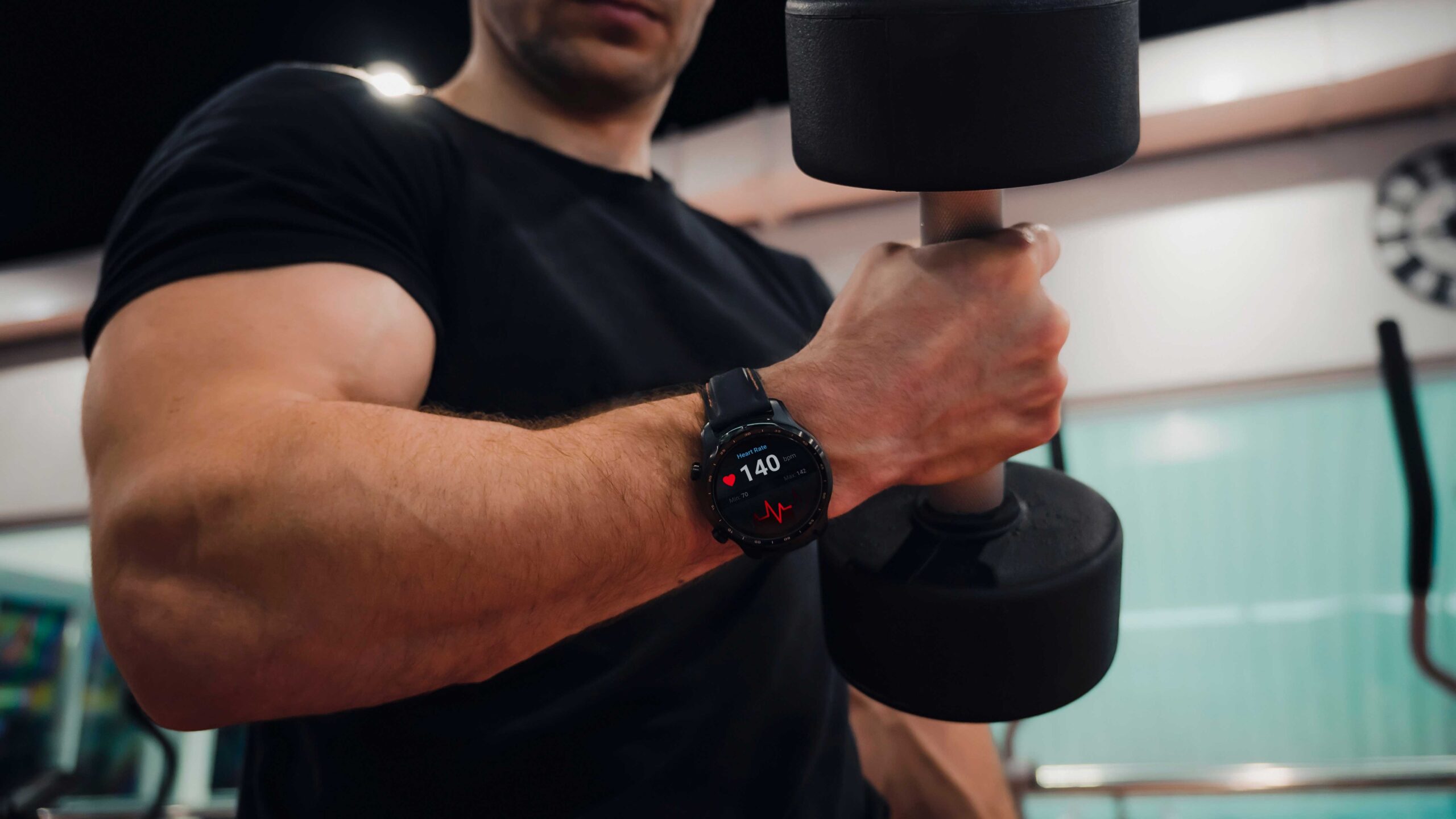
Situation 1: Let's say you're doing a circuit training workout with dumbbells. You start with a set of bicep curls, move on to some lunges with dumbbells, and then finish with some tricep extensions.
During the bicep curls, you notice that your heart rate is lower than you expected, and you're not burning as many calories as you'd like. Using the real-time data tracking on your wearable device, you can see that your heart rate is below your target heart rate zone.
To make an adjustment, you could increase the weight of your dumbbells or do more reps in each set to increase the intensity of the exercise and bring your heart rate up.
Situation 2: During the lunges with dumbbells, you notice that your form is not quite right, and you're not feeling the exercise in the muscles you want to target. Using the real-time data tracking on your wearable device, you can see that you're not engaging your glutes as much as you should be.
To make an adjustment, you could focus on engaging your glutes more during the exercise by squeezing your butt muscles at the top of each lunge. You could also try adjusting your stance or the weight of your dumbbells to better target your glutes.
Situation 3: Finally, during the triceps extensions, you notice that you're feeling fatigued and that your heart rate is higher than you'd like. Using the real-time data tracking on your wearable device, you can see that you've been working at a high intensity for too long.
To make an adjustment, you could take a break between sets to bring your heart rate down and let your muscles recover. You could also decrease the weight of your dumbbells or do fewer reps in each set to decrease the intensity of the exercise and prevent burnout.
How to track muscle engagement with wearable technology?
There are a few types of wearable tech that can help you track the engagement of your muscles during a workout. One option is electromyography (EMG) sensors, which can be placed on your skin over the muscles to measure their activity. Another option is motion sensors, which track your movements during a workout and can provide feedback on your muscle activation.
Of course, one might ask: do we really need to track the engagement of our muscles during a workout? Can't we trust that our muscles are doing what they're supposed to do? After all, we've been working out for centuries without the aid of fancy sensors and gadgets.
But then again, perhaps wearable technology is the key to unlocking our true potential. Maybe we've been missing out on maximum muscle gains all this time simply because we didn't have the right tools.
In all seriousness, whether you use wearable technology to track your glute muscle engagement during a dumbbell workout is a personal choice. It can be a useful tool for providing feedback and ensuring that you're targeting the right muscles, but it's not necessary for everyone. The most important thing is to listen to your body, and work out in a way that feels safe and effective for you.
Bonus #2
5 ways of getting stronger – in less time
1. Focus on compound exercises: exercises that work multiple muscle groups simultaneously, which means you can get more bang for your buck with fewer exercises. Think squats, deadlifts, bench presses, and rows - those big, badass exercises that make you feel like a superhero.
2. Use heavier weights with fewer reps: If you want to get stronger, challenge your muscles with heavier weights. But you don't necessarily need to do a ton of reps – in fact, lifting heavier weights for fewer reps can be just as effective (and way less time-consuming).
3. Take shorter rest breaks: Don't waste time chatting or scrolling through Instagram between sets – keep your rest breaks short and sweet, so you can get through your workout more quickly. Aim for rest breaks of around 45–90 seconds between sets.
4. Use super-sets and circuits: Super-sets and circuits are a great way to save time and increase the intensity of your workout. Instead of doing one exercise at a time, you can pair exercises together or do a series of exercises back-to-back with little to no rest in between. This will keep your heart rate up and help you build strength and endurance at the same time.
5. Don't neglect your nutrition and recovery: Even if you're trying to save time or cut down on effort, you can't ignore the other important factors that support your strength training goals. Make sure you're eating a balanced diet with plenty of protein, getting enough rest and recovery time, and staying hydrated. All of these factors will help you maximize your strength training gains and keep you feeling strong and energized.

Dumbbell training FAQ
To perform exercises with proper form and technique, you'll want to focus on maintaining good posture, keeping your core engaged, and moving through a full range of motion. Common mistakes to avoid include:
- Using momentum to lift the weights.
- Arching your back.
- Using improper grip or hand placement.
A personal trainer can demonstrate proper form and provide feedback on your technique to help you avoid injury and get the most out of your workouts.
To use dumbbells safely and effectively, it's important to warm up properly, use proper form and technique, and choose weights that are appropriate for your fitness level and goals. Common mistakes to avoid include using too much weight, rushing through exercises, and neglecting to cool down and stretch after your workout.
To maximize the benefits of dumbbell workouts, it's important to fuel your body with proper nutrition and give your muscles time to recover between workouts. Eating a balanced diet with plenty of protein, carbohydrates, and healthy fats can help support muscle growth and repair. Getting plenty of sleep and incorporating rest days into your workout routine can also help to prevent injury and improve overall performance. And remember to hydrate before, during, and after your workouts.